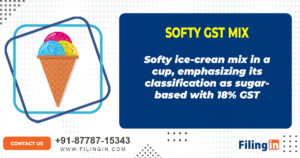The Goods and Services Tax (GST) landscape in India has always been a subject of discussion and debate, especially when it comes to product classifications. In a recent ruling by the Rajasthan bench of the GST Authority for Advance Rulings (AAR), an important decision was made concerning the taxability of softy ice-cream mix. The ruling determined that this particular product, sold by VRB Consumer Products, is primarily sugar-based and, as such, will attract an 18% GST rate. The decision highlights a critical classification issue between sugar-based and dairy products, impacting both manufacturers and consumers.

Understanding the AAR Ruling
The AAR’s decision revolves around a key classification issue: Is the softy ice-cream mix a sugar-based product or a milk-based one? Let’s break down the essential details of this ruling and understand why this distinction matters.
Why the Classification Matters
The difference between sugar-based and milk-based products isn’t just a technicality. It determines the GST rate a product will attract. Sugar-based products are subjected to an 18% GST rate, while milk-based products may qualify for a lower 5% GST rate. In this case, the AAR ruled that the softy ice-cream mix is sugar-based, thus attracting the higher tax rate.
The Composition of the Softy Ice-Cream Mix
The ruling emphasized that the softy ice-cream mix in question contains 61.2% sugar and only 34% milk solids. Given this composition, the AAR ruled that the product cannot be classified as a milk product under Heading 0404, which covers products consisting of natural milk constituents.
Heading 0404 – What Does It Cover?
Heading 0404 of the GST tariff applies to products made primarily from milk or natural milk constituents. If VRB Consumer Products’ softy ice-cream mix had been classified under this heading, it would have been eligible for a lower GST rate of 5%. However, the AAR ruled against this classification due to the product’s high sugar content and the presence of additives such as stabilizers and flavorings.
The Role of Additives in the Classification
Another critical factor in the ruling was the presence of additives. The inclusion of stabilizers and flavorings in the softy ice-cream mix further distanced it from being classified as a natural milk product. This highlights a growing trend in GST classifications, where even small additives can significantly impact a product’s tax classification.
Expert Opinions on the Ruling
Harpreet Singh, a Partner in Indirect Tax at Deloitte India, weighed in on the ruling. He noted that the decision rested on a crucial point: the fact that milk solids were added to sugar, not the other way around. This reversed the common assumption that products containing milk solids should be considered dairy products, solidifying the AAR’s decision to classify the mix as sugar-dominant.
A Precedent for Similar Products
The decision sets a precedent for other similar products that may contain a combination of milk and sugar. It clarifies that if sugar is the dominant ingredient, the product will be taxed at a higher rate, regardless of the presence of milk solids.
Other Notable GST Rulings on Dairy Products
This ruling is not an isolated case. Several products containing milk have been subject to GST rulings that have sparked debates. For instance, while lassi was ruled exempt from GST, flavored milk was subjected to a 12% GST rate in a previous ruling. This inconsistency in the treatment of milk-based products underscores the complexities of GST classifications.
Impact on Manufacturers
For manufacturers like VRB Consumer Products, the 18% GST rate is significant. The company had requested a lower tax rate by attempting to classify its Vanilla Mix under a milk-based product category. However, with the AAR ruling in favor of the higher tax rate, the financial implications for manufacturers of similar products are substantial.
Impact on Consumers
Higher taxes for manufacturers often mean higher prices for consumers. With the 18% GST rate on softy ice-cream mix, consumers may see a rise in the price of their favorite soft-serve ice creams. As sugar-based products tend to carry a higher tax burden, the cost of these sweet treats could increase.
The Larger Implications of the Ruling
The AAR’s ruling on the softy ice-cream mix has broader implications for the food and beverage industry. Many products that consumers assume are milk-based could actually be taxed at higher rates if sugar is the dominant ingredient. This case highlights the need for clarity in product labeling and composition to avoid unexpected tax rates.
What Does This Mean for Future GST Rulings?
This ruling could pave the way for future decisions where products with mixed compositions are involved. It sets a benchmark for how the GST authorities may handle similar cases, emphasizing the importance of determining the dominant ingredient in such products.
The Importance of Product Transparency
Manufacturers will need to be more transparent about the ingredients in their products to avoid misclassification. The GST rate can significantly impact both pricing and competitiveness in the market, so clear labeling and composition details will become even more critical.
The AAR’s decision to classify softy ice-cream mix as sugar-based and subject it to an 18% GST rate is a landmark ruling. It not only impacts VRB Consumer Products but also sets a precedent for other manufacturers dealing with similar products. As the GST landscape continues to evolve, clarity around product compositions and their classifications will become increasingly important for businesses and consumers alike.

